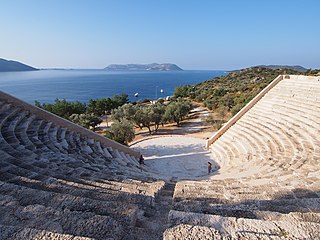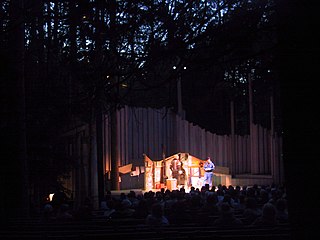 W
WAn amphitheatre or amphitheater is an open-air venue used for entertainment, performances, and sports. The term derives from the ancient Greek ἀμφιθέατρον (amphitheatron), from ἀμφί (amphi), meaning "on both sides" or "around" and θέατρον (théātron), meaning "place for viewing".
 W
WThis is a list of amphitheatres in use today.
 W
WThe Amphitheatre of Durrës is a Roman amphitheatre in the centre of the city of Durrës, Albania. Construction began under the emperor Trajan in the 2nd century AD and it was destroyed twice by earthquakes in the 6th and 10th centuries. It is the largest amphitheatre ever built in the Balkan Peninsula with once having a capacity of 20,000 people.
 W
WThe Cemil Topuzlu Open-Air Theatre is a contemporary amphitheatre located at Harbiye neighborhood of Şişli district in Istanbul, Turkey. It is situated across from the Istanbul Lütfi Kırdar Convention and Exhibition Center, and behind the Hilton Istanbul Bosphorus on the European side of the city.
 W
WThe Forest Opera is an open-air amphitheatre located in Sopot, Poland, with a capacity of 5047 seats, the orchestra pit can contain up to 110 musicians.
 W
WThe Fort Antoine Theatre is a small amphitheatre on the Avenue de la Quarantaine in the Monaco-Ville ward of Monaco. The fort hosts open air plays in the summer months.
 W
WThe Fulfillment Amphitheater is a large-scale outdoor amphitheater in Wen-Hsin Forest Park on Wenxin Road, Nantun District, Taichung, Taiwan. Every year, Taichung City Government holds "MidTaiwan Lantern Festival" here.
 W
WKanli Kula Fortress is an open-air amphitheater in Herceg Novi, Montenegro. The name is of Turkish origin, and means "bloody tower".
 W
WLe Dôme de Marseille is an indoor amphitheatre, located in Marseille, France. The capacity of the arena is 8,500 people.
 W
WBelow is the list of ancient amphitheatres in Turkey.
 W
WMilad Tower, also known as the Tehran Tower, is a multi-purpose tower in Tehran, Iran. It is the sixth-tallest tower and the 24th-tallest freestanding structure in the world.
 W
WNorthern Sky Theater is a professional theater company that creates, develops, and produces musicals based on the populist culture and heritage of the United States. Located in Door County, Wisconsin, the company began in 1970 as The Heritage Ensemble, performing on the stage of the 700-seat outdoor theater in Peninsula State Park. In 1990, American Folklore Theatre was co-founded by Fred Alley, Frederick Heide, and Gerald Pelrine. In 2015, the company changed its name to Northern Sky Theater.
 W
WA plen-an-gwarry or plain-an-gwary, is a "playing-place" or round, a medieval amphitheatre found in Cornwall. A circular outdoor space used for plays, sports, and public events, the plen-an-gwary was a Cornish variant of a construction style found across Great Britain. Formerly common across Cornwall, only two survive nearly complete today: the Plain in St Just in Penwith and Saint Piran's Round near Perranporth.
 W
WThe Quinta Vergara Amphitheater is an open-air amphitheater within the Parque Quinta Vergara in Viña del Mar, Chile. The amphitheater is the site of the Viña del Mar International Song Festival held yearly in February. The venue is owned by the Viña del Mar Municipality.
 W
WThe Sidney Myer Music Bowl is an outdoor bandshell performance venue in Melbourne, Victoria, Australia. It is located in the lawns and gardens of Kings Domain on Lithgow Avenue close to the Arts Centre and the Southbank entertainment precinct. It was officially opened by the Prime Minister of Australia, Robert Menzies, on 12 February 1959, with an audience of 30,000 people. It is listed on the Victorian Heritage Register.
 W
WThe Teatro del Silenzio is an open air amphitheater located in the city of Lajatico – the hometown of Andrea Bocelli - in the Tuscany region of Italy. In 2006, Bocelli convinced the municipality of Lajatico to build this outdoor venue whose structure utilizes the natural formations of the hilly landscape. Bocelli contributed greatly to its construction.
 W
WTekyeh Dowlat was a Royal Theater in Tehran, Iran. It was the most famous of all the ta'zieh performance spaces, for the Mourning of Muharram. It has a capacity for more than 4,000 people. Built in 1868 by Naser al-Din Shah Qajar south-east of the Golestan Palace on the site of the Síyáh-Chál, the Royal Theater's sumptuous magnificence surpassed that of Europe's greatest opera houses in the opinion of many Western visitors. It is comparable to Verona Arena, Samuel Greene Wheeler Benjamin told at his first visit.